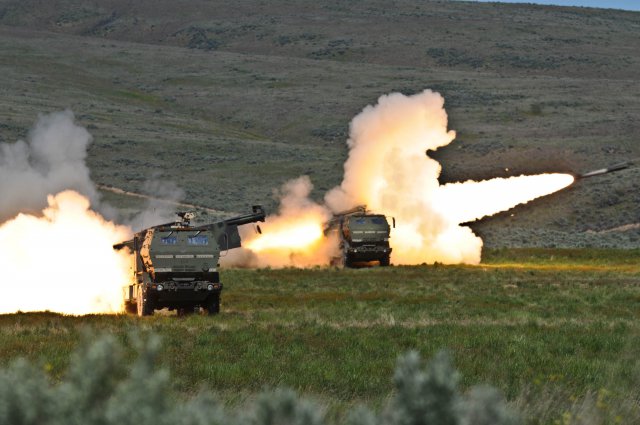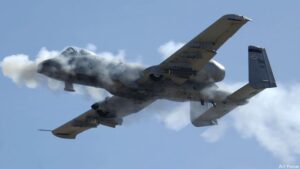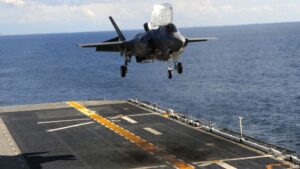
Army HIMARS trucks launch Guided Multiple Launch Rocket System missiles
WASHINGTON: The 18th Airborne Corps will host a live-fire experiment the first week of March, using artificial intelligence to share targeting data amongst Marine F-35s, Air Force A-10s, ground-based HIMARS rocket launchers, and commercial satellites.
The AI-driven system – developed in large part by 18th Airborne itself — is already mature enough to let the corps strike more targets, more quickly than ever before, wherever it deploys, the corps’ fire support coordination officer, artillery veteran Col. Joe O’Callaghan said.
“The AI we work with today is ready now; it’s ready to fight tonight, and we would take it forward with us,” O’Callaghan told me in an interview. It’s tied into what he called a “nascent JADC2 network” – short for Joint All-Domain Command & Control, a top Pentagon priority – that connects multiple services’ sensors from ground to air to space.

An A-10 “Warthog” firing its infamous 30 mm gun.
March’s wargames aren’t the only interservice AI fire-control experiments the 18th Airborne is involved in. One of the corps’ most famous units, the 82nd Airborne Division, will work with Marines and Special Operations in an Army Futures Command experiment in May called EDGE21: The 82nd will help direct attacks against “enemy” anti-aircraft units and conduct a heliborne infantry assault using IVAS targeting goggles.
Such AI-driven wargames are increasingly common in the military, as Breaking D readers know. But what’s unusual about the 18th Airborne Corps’ wargames in March is that a corps – a three-star field headquarters – is taking such a leading role. That’s not the result of some top-down Big Army initiative: Instead, the 18th Airborne’s commander, Lt. Gen. Erik Kurilla, is pushing to make his corps a pioneer for AI and big data in the Army.
To do that, the 18th Airborne reached out to the Army Futures Command, Pentagons’ Algorithmic Warfare Task Force – better known as Project Maven – and other centers of technical expertise. It’s also forged a relationship with the 2nd Marine Expeditionary Force, whose air wing will be providing the F-35B stealth fighters in March, and the Air Force’s 23rd Wing, which will provide A-10 ground attack jets.

F-35B in vertical landing mode.
How do the new technologies, tactics and relationships change how the 18th Airborne Corps can fight? “The first thing you would notice…it’s a lot quicker,” O’Callaghan told me. “In the past,” he explained, “we set horizons of 24, 48, and 72 hours” to plan strikes, using traditional coordinating mechanisms such as the Air Tasking Order, which arranges air support, and the Fire Support Coordination Line, with shorter-range targets for Army artillery on one side and longer-range ones for airstrikes on the other. But the speed of AI is too fast for the ATO cycle, O’Callaghan said, and the range of new Army missiles in development will be too long for the FSCL to tidily divide the battlefield.
“That will challenge the traditional concepts,” he told me.
AI doesn’t just help spot potential targets, O’Callaghan told me. It also helps assess how the enemy is fighting, the importance of different targets in that enemy plan, and whether a given target is worth expending “exquisite” (and expensive) precision-guided weapons on. It can even help humans weigh whether they should kill a particular target.
The AI even lets targeteers use data that was historically “dropped on the cutting room floor.” Historically, you only had time to analyze positive data: ISR reports that showed potential sightings of the enemy. Because the AI can crunch so much more data, it can also analyze negative data — in other words ISR that shows where the enemy isn’t. AI can help tease out telltale patterns in such absences, O’Callaghan said: “If we have not seen anything over there… what does that mean?”
It’s a new way for humans to look at the battlefield, made possible by AI, and it requires the humans to think about the world and data in new ways. “There’s a cultural change occurring in the Army [to] become a data-literate force,” O’Callaghan told me.
Lockheed Martin projects potential $1 billion loss on classified program
Lockheed CFO Jay Malave said the company currently expects the program to become profitable on an annual basis around the 2028 timeframe.


























